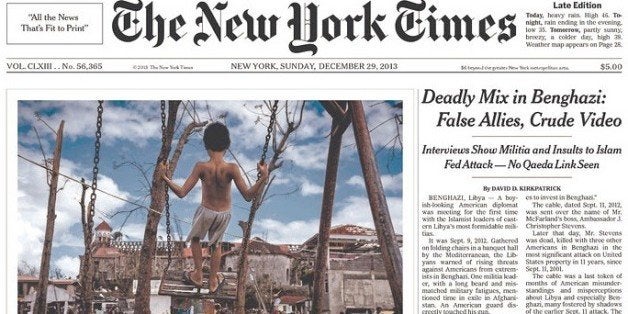
NEW YORK -– Following a months-long investigation, The New York Times reported Saturday that it had found no evidence that al-Qaeda, or any international terrorist group, was involved in the Sept. 11, 2012, attack on a U.S. diplomatic facility in Benghazi, Libya. The Times’ David Kirkpatrick also wrote that the attack “was fueled in large part by anger at an American-made video denigrating Islam,” an assessment that's prompted much chatter on Twitter and the Sunday morning talk shows.
The Obama administration originally pointed to the YouTube video, "Innocence of Muslims," as a primary factor in the attack. But Republicans challenged that version of events, and the media had largely dismissed the notion that the video played a major role.
Although the Times' front-page story has already generated significant attention, Saturday's reporting on the video's role essentially confirms what the Times originally wrote more than 15 months earlier.
On Sept. 12, 2012, the Times reported that "fighters involved in the assault” told its reporters of being "moved to attack the mission by anger over a 14-minute, American-made video."
Kirkpatrick and Steven Lee Myers wrote the Times' early coverage, with journalists Osama Alfitory and Suliman Ali Zway contributing on-the-ground reporting from Benghazi. The Times reported that many attackers “were determined to defend their faith from the video’s insults."
Four days later, National Security Adviser Susan Rice famously hit the Sunday talk show circuit and said that the Benghazi attack had grown spontaneously out of anger over the anti-Islam video.
But the Obama administration's narrative later shifted, and within weeks, the prevailing view in Washington was that the attack had been planned in advance. That brought fresh scrutiny on early reports by The New York Times and Reuters, each of which included eyewitness claims that the video was a large factor in the attack.
On Oct. 14, 2012, Times foreign editor Joseph Kahn stood by the paper’s early coverage.
“We have no reason to suspect in those subsequent contacts that our initial reporting was wrong, and we have had several stories that filled out the timeline of events more thoroughly than was possible in the immediate aftermath,” Kahn told The Huffington Post.
Kahn said, “It may well be true that the attack was planned before the video or simply took advantage of the video.” But, he continued, “there is no reason to believe that what participants in the attack told our reporter was false or that we were wrong to report it.”
In the Times' latest report, Kirkpatrick wrote that "anger at the video motivated the initial attack."
"Dozens of people joined in, some of them provoked by the video and others responding to fast-spreading false rumors that guards inside the American compound had shot Libyan protesters. Looters and arsonists, without any sign of a plan, were the ones who ravaged the compound after the initial attack, according to more than a dozen Libyan witnesses as well as many American officials who have viewed the footage from security cameras."
On NBC’s “Meet the Press” on Sunday, Kirkpatrick reiterated that what happened in Benghazi was "an armed terrorist attack motivated in large part by the video."
But Kirkpatrick, who serves as the Times' Cairo bureau chief, pushed back on host David Gregory's contention that the just-published investigation bolsters Rice's Sept. 16, 2012, claims on the Sunday shows. Kirkpatrick said that Rice made “some clear misstatements.”
"This was not a street protest. And it was not a copycat of what happened in Cairo," Kirkpatrick said, referring to the demonstration the same day in the Egyptian capital in response to the YouTube video. "That was unarmed street protest. This is a group of armed men who, inspired by the video, deliberately attacked the compound."
